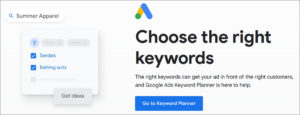Digital ads can be categorized by format (text vs image vs video) or channel (email vs website vs search engine vs social media). Google Ads have become a dominant marketing tactic, but there are still many variables when deciding what path makes sense for your brand. With Google and other search engines, the pay-per-click (PPC) method of ad pricing allows you to test various formats, topics, audiences and more at a flexible budget so you can hone your strategy and settings.
What Are PPC Ads?
Google ads display on a search engine results page (SERP) when users type in relevant keywords. Google charges when someone clicks on the ad. Simple as that.
The algorithm that determines what that click cost is set to is more complicated – combining the search volume with competitor bids, your budget and other variables – but the basic structure is simple:
- Setup your ad with budget, ad text, keywords and audience demographics
- When a search engine user types in a relevant query, your ad appears on the page
- If someone clicks on the ad, you’re charged for that action
If no one clicks on the ad, you’re never charged. You basically get the impressions for free. And impressions are still valuable. Not only are they good for branding (people are still seeing your company name and reading your ad copy), but impressions also tell you the search volume for your relevant keywords and terms, allowing you to gauge audience size and effective customer language.
Creating the Ad Text
Crafting the right ad to capture the users’ attention is more than just writing appealing copy. You must do this all in less character space than a typical Tweet. The search engines all require an ad to have a headline, description, and URL, but each platform has their differences. For example, Google requires two headlines within a 30-character limit. The minimum four description lines only allow a 90-character limit. Search engine ads force you to be as direct and succinct as possible. People have short attention spans, after all.
Choosing the Right Keywords
 Choosing the right keywords are important for a brand to achieve a strong return on investment (ROI). This is the second part of making sure your ads go from capturing impressions to actually converting those views to clicks to your website.
Choosing the right keywords are important for a brand to achieve a strong return on investment (ROI). This is the second part of making sure your ads go from capturing impressions to actually converting those views to clicks to your website.
Certain keywords are more valuable than others, based on those algorithm details mentioned earlier. Google needs to find the right amount to charge for each keyword. One way this is handled is through bidding. The higher a company bids on a keyword, the more likely their ad will rise to the top of the search results.
All of this is dependent on Google agreeing that your keywords are relevant to your ad topic and destination URL. Part of the reason that algorithm is in place is to ensure your ads are getting to the right people, and conversely, that the searchers are seeing relevant copy. Everyone needs to be happy.
A useful way to find keywords is through Google’s Keyword Planner Tool. It’s a great way to evaluate keywords based on relevance, popularity and cost. Other companies also provide search engine marketing (SEM) tools, such SEMrush.
Monitor Your Ads
Data always has a story to tell. Monitoring the results from your ads is the only way to improve your ROI. Determine what KPIs are important for you, then set up reports to see if you’re reaching your goals. If you feel the ads aren’t gaining the amount of attention desired, check the keywords, bidding, ad text, and ad graphic to find any problematic areas. Don’t be discouraged – it takes a while to see results. Checking your ads after a day or a week won’t provide any trends. Give your new ads at least a month to accumulate results data before making any strategic decisions.
Why Use Google PPC Ads
 The PPC pricing strategy for Google Ads allows you to set your own budget, providing the flexibility to test ad copy, big strategy, keywords, audience demographics and other settings until you find what works best for your company. Since the keywords are directly related to what searchers are using in real time, it’s also an effective way to keep up with the latest terminology used by your customers (and even your competitors).
The PPC pricing strategy for Google Ads allows you to set your own budget, providing the flexibility to test ad copy, big strategy, keywords, audience demographics and other settings until you find what works best for your company. Since the keywords are directly related to what searchers are using in real time, it’s also an effective way to keep up with the latest terminology used by your customers (and even your competitors).
Ready to Get Started?
Here’s our suggested plan of action:
- Pick your destination URL (where people go when they click your ad). This will help you decide your topic, tone and conversion metrics.
- Write your ad copy with the minimum headlines and description lines outlined previously. Include at least 2 distinct ads in the campaign to test what messaging is resonating with your audience.
- Use the keyword planner tool, as well as competitor research and insights from your internal team, to set a list of 5-10 keyword themes.
- Set your daily budget. Start with the lowest allowed by Google if you’re really unsure.
- Define basic audience demographics, like location.
- Launch the campaign and let it run for a month. Run reports and start analyzing the data to see if you’re getting the expected results.
- Don’t forget to check the suggestions from Google to improve your campaign. Their algorithm sees much more than any one person will analyze.

